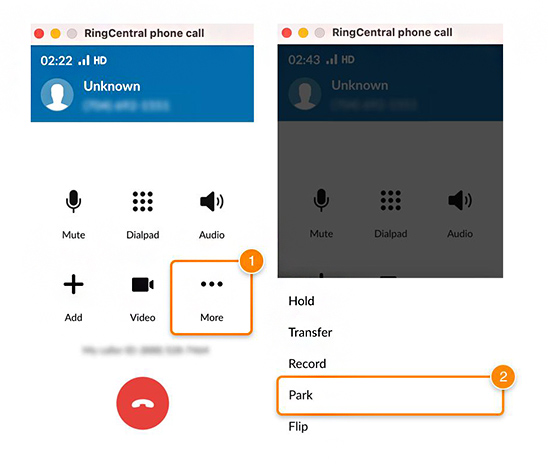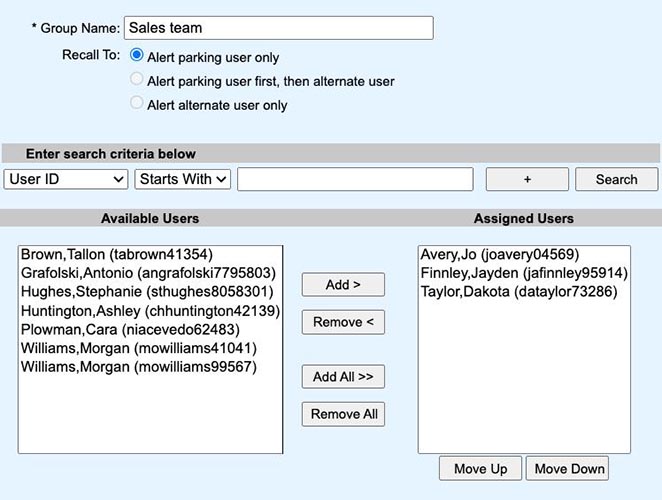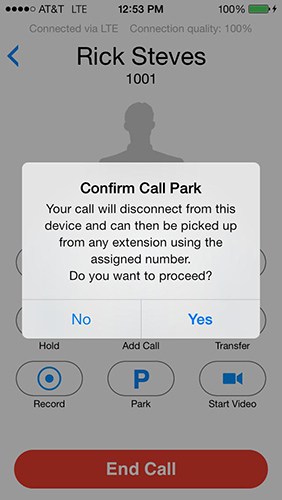Call parking is a voice-over-internet-protocol (VoIP) feature enabling users to put an active call on hold and place it in a virtual waiting room or “communal parking lot,” allowing team members to pick it up. Aside from promoting better collaboration, it also drives flexibility, as users have the ability to answer calls from anywhere, on any extension or device. Ultimately, this tool improves call center efficiency and customer service delivery.
How Call Parking Works
To answer the question “What is call parking?” we must understand how it works. Business phone systems with desktop and mobile apps display call park as an option during a live call, along with other standard features, such as mute, hold, and transfer. On a desk phone, press the transfer button followed by the parking orbit number, the virtual room where you want the call to be parked.
Once you click or press the call park feature, the system automatically places the caller on hold and puts them in the communal parking spot. Below are the specific steps involved in the call parking process.
- A customer calls the business, and an agent picks up the call.
- After learning the customer’s concern, the agent decides to park the call and lets other team members accommodate the caller. They click or press the call park button.
- The agent keys in the parking orbit number on the desk phone or chooses among the virtual rooms shown in the softphone app.
- The call goes to the communal parking lot. While waiting for an available agent, the caller hears pre-recorded music or announcements.
- An agent retrieves the parked call, or the phone system re-alerts the one who placed the call in the waiting room.
- Depending on your phone system, the parked call remains parked for a certain period. When the time limit is up, and no agent has picked up the parked call, the system automatically rings the person who parked the call again.
- If another agent sees the parked call and decides to retrieve it, they will dial the parking orbit number on the softphone or desk phone. They will be instantly connected to the waiting caller.
Types of Call Parking
Another way to understand what is call parking is to be familiar with its various types: simple, advanced, and private location. Each has unique functions, making it the ideal option for specific customer service needs. Learn about different types of parking a call in the table below:
Difference Between Call Park, Call Transfer & Call Hold
Now that we have pinned down what is call park, it’s important to address how it differs from other VoIP business phone features, which have relatively similar functions, like call transfer and call hold. Both call park and call transfer allow other team members to take over a call. They are options made available during a live call.
However, the difference is that call transfer directs the call to a specific agent. Call park, specifically simple call parking, puts the call in a communal spot, giving multiple team members access to the call.
Meanwhile, call hold and call park allow agents to pause the conversation while gathering information about a customer concern. The difference is that in call hold, only the agent who placed the call on hold will be able to pick it up again from the same phone, whereas call park lets other team members retrieve it from any phone in the system. By spelling out how each feature is distinct from the other, you gain a better grasp of what it means to park a call.

The RingCentral app features call park, transfer, and hold. (Source: RingCentral)
RingCentral is a unified communications platform that features various call control options, including park, transfer, and hold. When you choose call park, a pop-up appears, prompting you to decide where to place the call: in a public virtual waiting room or a specific extension number. After selecting, a dialog box confirms that the call is parked at your chosen location.
The VoIP feature is available on both the provider’s desktop and mobile apps. Learn more about it by checking our in-depth RingCentral review.
Benefits of Call Parking
Call parking is especially beneficial when your phone system regularly receives a huge volume of calls. Since all the other agents get access to the parked calls, you cut down the long call queue and shorten the customers’ waiting time. This contributes to better client service. Here are the other benefits you get when you park calls:
Business phone systems only support a certain number of calls in a queue. If you receive a large number of calls daily, the number of incoming inbound calls might exceed the limit and keep you from accommodating more. With call park, you’ll be able to receive more calls as the others are in virtual waiting rooms. With this, your phone line remains available, and no call goes to voicemail.
Call park features help agents share the task of resolving customer queries. A team member who needs assistance has the option to let other service representatives take over the call while gathering information.

Create a call park group in NextOS (Source: Nextiva)
Nextiva is a reliable unified communications (UC) software offering call park in NextOS, its all-in-one platform for VoIP and customer relationship management (CRM). It allows users to create a call park group in which any member is able to retrieve a parked call. Nextiva desk phones also have call park capabilities. To enable this functionality, hit the transfer button, dial *68, key in the extension you wish to park the call at, and press #.
Advanced call parking lets you park phone calls and assign team members to attend to them. As the most qualified agents accept the calls, they easily understand concerns and resolve them faster than others on the team. With improved average handle time (AHT), customers have a more pleasant experience communicating with your business.
While another team member is able to retrieve a parked call, call park also allows the same agent to resume the call from a different device. This means you’ll be able to switch devices easily according to need or preference. Continue the conversation even when you need to be away from your work desk and step out of the office.

Use the call park feature on 8×8’s mobile app (Source: 8×8)
8×8, a VoIP platform, features a call park in its softphone, readily displaying it as a call control option in an ongoing call. Moreover, the provider lets users dedicate extension numbers for call park and assign them to a busy lamp field (BLF) or speed dial key.
When a call comes through for a specific team in your company, your receptionist will simply press the assigned BLF key to park the call for that department. A team member sees the BLF light blinking and retrieves the call by pressing the BLF key.
If you’re interested in using this VoIP provider in your customer service operations, note that the monthly pricing per user starts at $28. Before subscribing, explore its pros and cons by reading our comprehensive 8×8 review.
When to Use Call Parking
When used correctly, call parking helps streamline call handling, enabling agents to be more efficient in providing customer service. These are the specific situations call parking will be most useful for:
- Needing time to consult colleagues for advice on a customer concern: As the client is on hold in the virtual waiting room, ask fellow team members how to resolve the inquiry. At the same time, let more experienced team members address concerns directly.
- Handling a large volume of calls: By parking calls, you provide access to multiple agents to accommodate callers. This lets you cover as many calls as possible and accept plenty more.
- Transferring calls but not sure which department: If a particular concern isn’t your expertise, but you’re uncertain which team handles it, park the call and write a note informing agents about the customer concern. The appropriate department will pick up the call from the communal parking lot.
VoIP Platforms With Call Parking
Many business phone providers are equipped with call parking, offering it as a standard feature. Below are some excellent options worth considering:
Frequently Asked Questions (FAQs)
Visual call park is a business phone feature allowing users to see which communal parking slots are occupied. Through this tool, it’s easier to decide where to park incoming calls. Visual call park is often available in a desktop app and browser.
Dynamic call parking is a desk phone feature that enables the system to automatically assign parking spots to inbound calls. Usually, devices with limited speed dial keys, like cordless phones, have this capability.
The general consensus is that you shouldn’t keep a customer waiting for more than two minutes. This is the duration most people are willing to stay on the line before getting frustrated.
Bottom Line
Call park is a useful VoIP feature for companies with high-volume calls and long call queues. By giving more agents access to phone calls, the team is able to work together in resolving more inquiries. Consider the top VoIP solution, RingCentral, if you’re looking for a powerful phone system with a robust call park feature. Sign up for its 14-day free trial.

